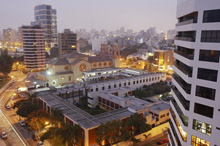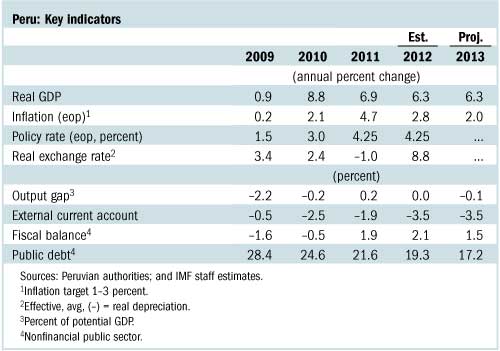
Typical street scene in Santa Ana, El Salvador. (Photo: iStock)
IMF Survey : Peru: Latin America’s Economic Performer
February 22, 2013
- Peru’s economy remains resilient despite global uncertainty
- Outlook is positive, but with risks in both directions
- Reforms needed to sustain high growth, increase productivity
Following a decade of record-high growth, Peru’s economy has remained strong and resilient despite the persistent global uncertainty, thanks to strong fundamentals, supportive terms of trade and sound policy management.

The Miraflores District in Lima, Peru. The country is one of the fastest growing and most stable economies in Latin America, says the IMF (photo: Davide Scagliola/ZUMA Press/Newscom)
Economic Health Check
In its latest assessment of the Peruvian economy, which was discussed by the IMF’s 24-member Executive Board on February 13, the IMF said that Peru has emerged as one of the fastest growing and most stable economies in Latin America.
Over the period 2002–12, the Peruvian economy almost doubled in size, real GDP grew at an average annual rate of 6â…“ percent (the highest 10-year average growth in Peru’s history), and the average annual inflation rate fell to 2¾ percent (the lowest in the region).
Economic growth has been gradually slowing toward potential, the IMF said. Real GDP growth has moderated to 6â…“ percent in 2012, down from 7 percent in 2011. Economic activity in 2012 was driven by investment, as the weak external environment took a toll on exports and worsened the external current account.
With an exchange rate broadly in line with fundamentals, the authorities’ policies have been geared toward managing the appreciation pressure of the new sol from a surge in capital inflows. This led to substantial intervention in the foreign exchange market ($13 billion in 2012) and sterilization of the liquidity created. At the same time, the fiscal position remained strong and the authorities have been able to rebuild fiscal buffers.
Favorable outlook, but risks remain
For 2013, real GDP growth is expected to remain around potential—at 6â…“ percent—and inflation to continue to fall as supply shocks unwind.
On the downside, the economy is most vulnerable in the short term to a global growth shock that permeates through lower commodity prices. A prolonged period of low growth in the U.S. economy could also hamper Peru’s economy over the medium term.
On the upside, upward momentum to growth and inflation could come from large capital inflows and strong credit dynamics in the context of ample global liquidity and continued low growth in advanced economies.

Policy priorities
The IMF said that the overall policy stance has been broadly appropriate as the economy is growing close to potential, inflation is expected to converge to the middle of the target band (2 percent), and capital inflows are expected to ease somewhat. The central bank stands ready to react to risks associated with strong domestic demand, large capital inflows, and rapid credit growth.
Fiscal policy focuses on achieving fiscal surpluses and attending to immediate social needs while continuing to build fiscal buffers. The proactive use of prudential measures is welcome, but the IMF noted that further efforts may be needed to deter excessive lending and prevent asset price booms.
In the context of heightened global uncertainty, the authorities are committed to maintaining policies flexible given the two-sided risks to the outlook. The IMF recognized that Peru is well positioned to cope with negative spillovers. If upside risks materialize, policy coordination will need to be strengthened to ensure a timely and effective response to any threat of overheating.
Ensuring high sustainable growth
In the IMF’s assessment, the medium-term economic outlook hinges on building greater resilience to shocks and increasing productivity.
The authorities agreed that an ambitious reform agenda is needed to cement high sustainable growth and support a more socially inclusive growth strategy. This will require improvements in productivity and competitiveness by boosting human capital and maintaining labor market flexibility. It will also be important to remove infrastructure bottlenecks, improve the business climate further, and develop local capital markets, the latter to channel resources more effectively through the economy.
Finally, strengthening the fiscal framework would require adopting a fiscal anchor that ensures Peru’s nonrenewable wealth is appropriately managed and avoids procyclicality (policies that magnify economic fluctuations). The IMF also acknowledges the authorities’ efforts to strengthen tax administration, and encouraged the authorities to take the necessary measures to ensure that the government’s goal of raising tax revenues to 18 percent of GDP by 2016 is achieved.


